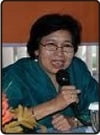Keroncong Music Reflects the Identity of Indonesia
Abstract
ABSTRACT: During the course of its history, “keroncong” which is an Indonesian music was popular during the 1970s and 1980s. However, in its development, “keroncong” music has changed and it gradually reflected the personality of Indonesia. But, the development of information technology in 1990s has an impact on the “keroncong” music and since it has made the “keroncong” less popular. There are some preservations towards the “keroncong” music. One of them is the effort from the young generation in performing “keroncong” music, which is by incorporating elements from other musical genres such as “Rock”, “Jazz”, and “Dangdut” (Malay orchestra music), so new terms of “Cong-Rock”, “Cong-Jezz”, and “Cong-Dut” began to appear. Finally, “keroncong” music, which is much older than the Republic of Indonesia (1945), has actually contributed to and an active role in the struggle for Indonesian independence and has also been translated into various international languages. “Keroncong” music has grown and evolved, showing the identity and personality of the Indonesian nation. That way, it is not an exaggeration if “keroncong” is proposed as a World Heritage.
KEY WORDS: “Keroncong” music, popular art, development and preservation, and Indonesian personality.

About the Author: Dr. Magdalia Alfian is a Senior Lecturer at the Department of History, Faculty of Humanities UI (University of Indonesia), UI Campus, Depok, West Java, Indonesia. She can be contacted via her e-mail address at: magdalia_alf10@yahoo.com
How to cite this article? Alfian, Magdalia. (2013). “Keroncong Music Reflects the Identity of Indonesia” in TAWARIKH: International Journal for Historical Studies, Vol.4(2) April, pp.171-186. Bandung, Indonesia: ASPENSI [Asosiasi Sarjana Pendidikan Sejarah Indonesia] and UVRI [Universitas Veteran Republik Indonesia], ISSN 2085-0980.
Chronicle of the article: Accepted (February 22, 2013); Revised (March 25, 2013); and Published (April 28, 2013).
Full Text:
PDFReferences
Alfian, Magdalia. (2006). ”Seni Pertunjukan dalam Perspektif Sejarah: Keberadaan Musik Keroncong di Indonesia”. Paper presented in the National Conference in Yogyakarta, Indonesia.
Alkatiri, Zeffry & Mathar Moehammad Kamal. (2013). “Modern Malay Rhythm Music Trend as Popular Culture in Indonesia, 1950-1960's: A Sociological Analysis” in TAWARIKH: International Journal for Historical Studies, Vol.4, No.2 [April].
Anggraini, Riski. (2012). “Musik Keroncong Masa Modern, 1960-2000” in http://musik-riskianggrainimusik.blogspot.com/2012/01/masa-keroncong-modern-1960-2000. html 24 april 2012 [accessed in Jakarta, Indonesia: 15 January 2013].
Article on ”Keroncong” in Ensiklopedia Indonesia, Vol.3. Jakarta: Ichtiar Baru — Van Hoeve, 1982.
Becker, Judith. (1975). “Kroncong: Indonesian Popular Music” in Asian Music, Vol.7, No.1. Southeast Asia Issue, University of Texas Press, pp.14-19. Available also at: http://www.jstor.org/stable/83 [accessed in Jakarta, Indonesia: 9 October 2012].
Boydon, David D. (1986). Introduction to Music. New York: Alfred A. Knopf.
Budiman, B.J. (1979). Mengenal Musik Keroncong dari Dekat. Jakarta: Perpustakaan Akademi Musik LPKJ [Lembaga Pendidikan Kesenian Jakarta].
Dekanipa, Gendot. (2008). “Proses Kreatif Orkes Keroncong Swastika dan Kontribusinya terhadap Perkembangan Musik Keroncong di Surakarta”. Unpublished Thesis Undergraduate. Surakarta, Central Java: ISI [Institut Seni Indonesia].
Desrilland. (2002). “Kroncong: Musik Khas Indonesia” in Jurnal Ekspresi Seni, Vol.V, No.2, pp.72-92.
Desta, Kelik Rahmanto. (2010). “Kegiatan Orkes Keroncong Irama Tongkol Teduh di Minomartani Yogyakarta”. Unpublished Thesis Undergraduate. Yogyakarta: Study Program of Educational Music, Faculty of Performance Art ISI [Institut Seni Indonesia].
Dinbud [Dinas Kebudayaan] Jakarta. (1986). Keroncong Tugu. Jakarta: Dinas Kebudayaan DKI [Daerah Khusus Ibukota] Jakarta.
Dirjen [Direktur Jenderal] Kebudayaan. (1978). Himpunan Lagu-lagu Keroncong. Jakarta, Indonesia: Departemen P & K [Pendidikan dan Kebudayaan].
Ganap, Victor. (2006). “Pengaruh Portugis pada Musik Keroncong” in HARMONIA: Jurnal Pengetahuan dan Pemikiran Seni, Vol.1(1).
Ganap, Victor. (2011). Kerontjong Toegoe. Yogyakarta: Badan Penerbit ISI [Institut Seni Indonesia].
Harmunah. (1996). Musik Keroncong: Sejarah, Gaya, dan Perkembangannya. Yogyakarta: Pusat Musik Liturgi.
Interview with dr. R.H. Soetomo at the Office of the “Indonesian Keroncong Center” in Jakarta, on 9 October 2012.
Interview with Pendi Hariyadi and Bambi in Surakarta, Central Java, Indonesia, on 25 December /2012
Kayam, Umar. (1981). Seni, Tradisi, dan Masyarakat. Jakarta: Sinar Harapan.
Kusbini. (1981). Lagu-lagu Keroncong Indonesia. Yogyakarta: Penerbit Sosi.
Mardjuki. (1971). “Keroncong adalah Asli Milik Bangsa Indonesia” in newspaper of Kompas. Jakarta: 6 January.
Mintargo, Wisnu. (2007). “Musik Keroncong, Akulturasi Budaya Barat dan Timur: Sebuah Analisis Metode Bronislaw Malinowski” in Jurnal KETEG, Vol.7, No.2 [November].
Munjid, Ahmad. (2001). “Perkembangan Musik Keroncong, 1920-1944”. Unpublished Thesis Undergraduate. Depok, West Java: Faculty of Arts UI (University of Indoesia).
Paramitha, Abdurahman R. (1977). “Keroncong, Moresco, Tanjidor, Ondel-ondel” in Budaya Djaya [academic magazine].
Pasaribu, Amir. (1986). Analisis Musik. Jakarta: Penerbit Simpati.
Reuters [news agency]. London, United Kingdom: 22 May 2010.
Ricklefs, M.C. (1992). Sejarah Indonesia Modern. Yogyakarta: Gadjah Mada University Press, Translation.
Sedyawati, Edi. (1981). “Pertumbuhan Seni Pertunjukan” in newspaper of Sinar Harapan. Jakarta: 8 June.
Sinar Harapan [newspaper]. Jakarta, Indonesia: 9 September 1978.
Sugiyanto, Danis. (2003). “Sumbangan Komponis Gesang Martohartono terhadap Musik Indonesia”. Unpublished Thesis Master. Yogyakarta: Postgraduate Program UGM (Gadjah Mada University).
Suharto, M. (1970). “Musik Keroncong” in newspaper of Kompas. Jakarta: 15 June.
Sukanti. (2002). “Waldjinah: Proses Pembentukan dan Perkembangannya sebagai Penyanyi Keroncong dan Langgam Jawa”. Unpublished Thesis Undergraduate. Surakarta, Central Java: STSI [Sekolah Tinggi Seni Indonesia].
Tambayong, Yopi. (2000). “Keroncong, Dangdut, Prejudis, Kekuasaan” in newspaper of Kompas. Jakarta, Indonesia: 1 January.
Tempo [weekly magazine]. Jakarta: 1 April 2012.
Widjajadi, Agus Sri & Nur Sahid. (2000). Mencari Ruang Hidup Seni Tradisi. Yogyakarta: Badan Penerbit Fakultas Seni Pertunjukan.
Widjajadi, Agus Sri. (2007). “Menelusuri Sarana Penyebaran Musik Keroncong” in Jurnal Pengetahuan dan Pemikiran Seni, Vol.6, No.2 [May-August].
